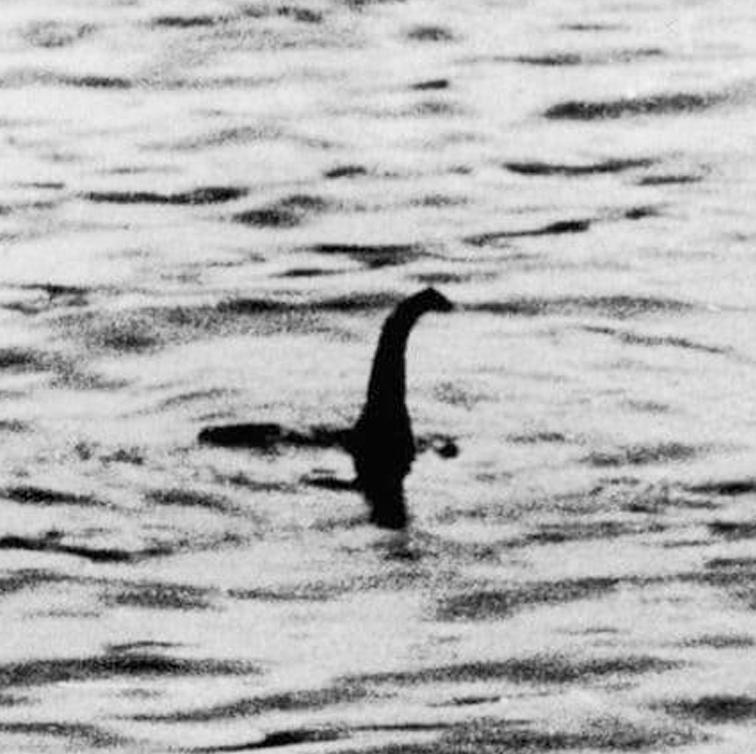One of the great tragedies in cryptozoology for people who take it super seriously and fun-loving hobbyists like me alike is that this phot was an out and out hoax.
Its a shame for the simple fact that of all of the possible Cryptids out there, this one is pretty possible.
Just like with the bigfoot/Gigantopithecus connection, we KNOW for a fact that a creature similar to what we think Nessie and company are existed. We have copious amounts of fossils to prove it. Also, just like bigfoot, there is vast amounts of barely explored habitat for this creature to exist in.
But, whether this one ever turns out to be real it sure is fun….and for almost a hundred years it has kept cryptozoology on the tips of many tongues, and in the back of many minds.
Here is some history of the Loch Ness Monster and its cousins.
History: Cryptids, creatures whose existence is suggested by anecdotal evidence but lacks scientific support, have captured the imagination of people around the world for centuries. One of the most famous cryptids is the Loch Ness Monster, said to inhabit the deep waters of Loch Ness in Scotland. The legend of the Loch Ness Monster dates back to ancient times, with tales of a mysterious water-dwelling creature known locally as “Nessie” or “Ness” being passed down through generations.
The modern fascination with the Loch Ness Monster began in 1933 when a newspaper report detailed an alleged sighting of a large, unidentified creature in Loch Ness. Since then, numerous sightings, photographs, and sonar readings have fueled speculation about the existence of this elusive creature.
Similar cryptids, such as Champ in Lake Champlain and Ogopogo in Lake Okanagan, share similarities with the Loch Ness Monster in terms of appearance and alleged behavior. These cryptids have their own regional names, lore, and reported sightings, contributing to the broader mythology of mysterious lake monsters.
Template to Describe Cryptids:
Regional Names:
- Loch Ness Monster: Nessie, Ness
- Lake Champlain Monster: Champ
- Lake Okanagan Monster: Ogopogo
Known Origin and Basic Lore:
- Loch Ness Monster: Originates from Loch Ness in Scotland. Lore suggests a large, serpent-like creature inhabits the deep waters of the loch, occasionally surfacing to be seen by witnesses.
- Lake Champlain Monster: Believed to inhabit Lake Champlain, spanning New York, Vermont, and Quebec, Canada. Described as a long-necked creature resembling a plesiosaur or sea serpent.
- Lake Okanagan Monster: Allegedly resides in Lake Okanagan in British Columbia, Canada. Said to resemble a large, serpentine creature with a humped back.
Significant Sightings:
- Loch Ness Monster: The “Surgeon’s Photograph” in 1934 is one of the most famous alleged sightings, though it was later revealed to be a hoax. Other notable sightings include the Dinsdale film in 1960 and various sonar readings.
- Lake Champlain Monster: Sightings date back centuries, with modern reports including multiple eyewitness accounts and alleged photographic evidence.
- Lake Okanagan Monster: Sightings have been reported by Indigenous peoples for generations, with modern sightings by residents and tourists adding to the lore.
Physical Description:
- Loch Ness Monster: Described as a long-necked creature with a humped back, resembling a plesiosaur or large aquatic reptile.
- Lake Champlain Monster: Often described as a serpentine creature with a long neck, similar to depictions of sea serpents.
- Lake Okanagan Monster: Reported to be a large, snake-like creature with a humped back and fins or flippers.
Behaviors:
- Loch Ness Monster: Allegedly exhibits behaviors such as surfacing briefly before submerging, moving with a serpentine motion, and disappearing into the depths of the loch.
- Lake Champlain Monster: Reported behaviors include swimming near the surface, diving quickly when approached, and occasionally basking in the sun.
- Lake Okanagan Monster: Said to swim swiftly through the water, sometimes creating large waves or disturbances.
Preferred Habitat:
- These cryptids are typically associated with deep, freshwater lakes, where they are said to inhabit murky waters and underwater caves.
Range of Sightings:
- Sightings of cryptids have been reported in their respective lakes, with Loch Ness in Scotland, Lake Champlain in the United States and Canada, and Lake Okanagan in Canada being the primary locations.
Likelihood of Existence:
- The existence of cryptids like the Loch Ness Monster, Champ, and Ogopogo remains unproven, with no conclusive evidence to confirm their existence. Some theories suggest that reported sightings may be attributed to misidentifications of known animals, optical illusions, or hoaxes.


